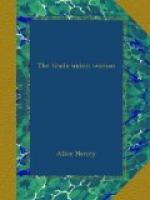The present national organization came into existence in 1881, under the style and title of the Federation of Trades and Labor Unions of the United States and Canada. It reorganized at the convention of 1886, and adopted the present name, the American Federation of Labor. It was built up by trade-union members of the skilled trades, and to them trade qualifications and trade autonomy were essential articles of faith. This was a much more solid groundwork upon which to raise a labor movement. But at first it worked none too well for the women, although as the national organizations with women members joined the Federation the women were necessarily taken in, too. Likewise they shared in some, at least, of the benefits and advantages accruing from the linking together of the organized workers in one strong body. But the unions of which the new organization was composed in these early days were principally unions in what were exclusively men’s trades, such as the building and iron trades, mining and so on. In the trades, again, in which women were engaged, they were not in any great numbers to be found in the union of the trade. So the inferior position held by women in the industrial world was therefore inevitably reflected in the Federation. It is true that time after time, in the very earliest conventions, resolutions would be passed recommending the organization of women. But matters went no further.
In 1882 Mrs. Charlotte Smith, president and representative of an organization styled variously the Women’s National Labor League, and the Women’s National Industrial League, presented a memorial to the Convention of the Federation of Organized Trades and Labor Unions (the Federation’s name at that time), asking for the advice, assistance and cooeperation of labor organizations. She mentioned that in 1880, there were recorded 2,647,157 women as employed in gainful occupations. A favorable resolution followed. At the convention of 1885, she was again present, and was accorded a seat without a vote. On her request again the delegates committed themselves to a resolution favoring the organization of women.
In 1890 Delegate T.J. Morgan, of Chicago, introduced, and the convention passed, a resolution, favoring the submission to Congress of an amendment extending the right of suffrage to women. At this convention appeared the first fully accredited woman delegate, Mrs. Mary Burke, of the Retail Clerks, from Findlay, Ohio. A resolution was introduced and received endorsement, but no action followed. It asked for the placing in the field of a sufficient number of women organizers to labor in behalf of the emancipation of women of the wage-working class.




